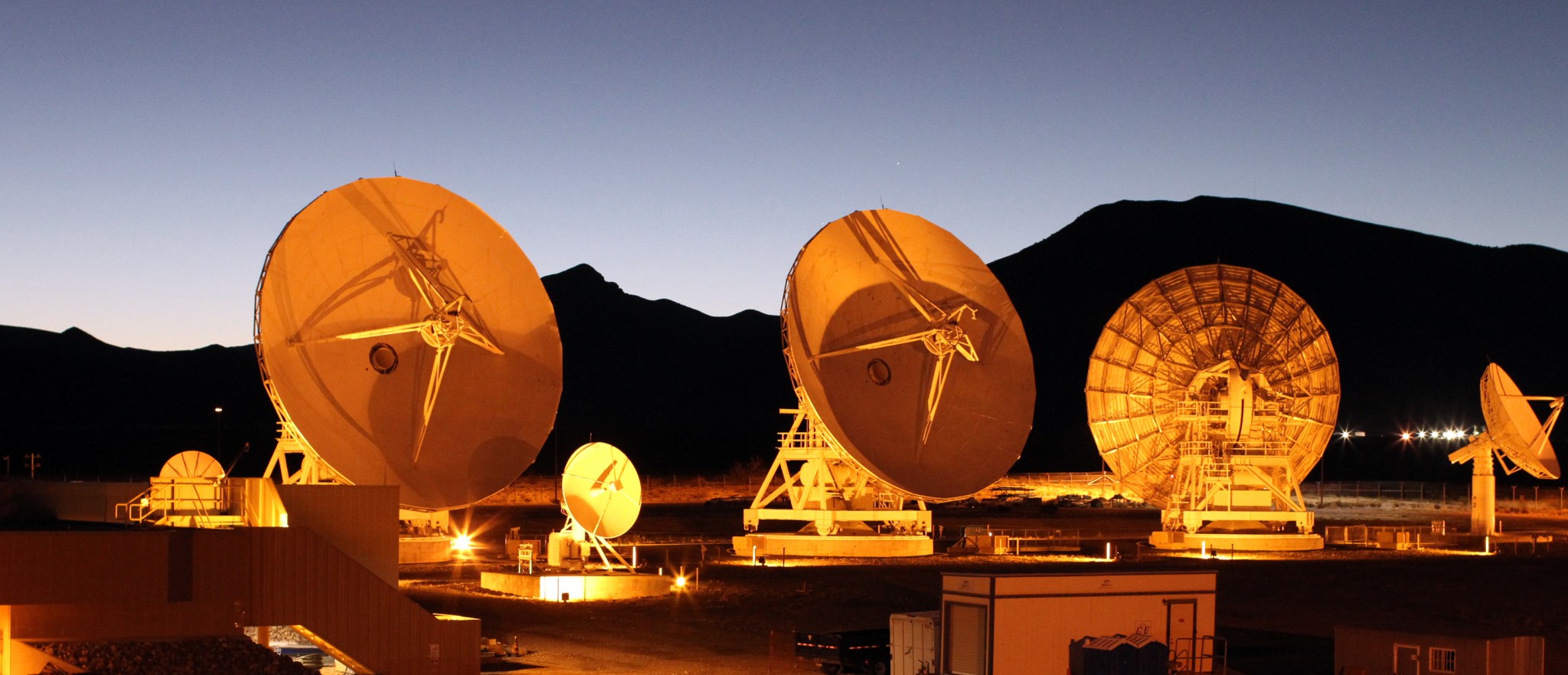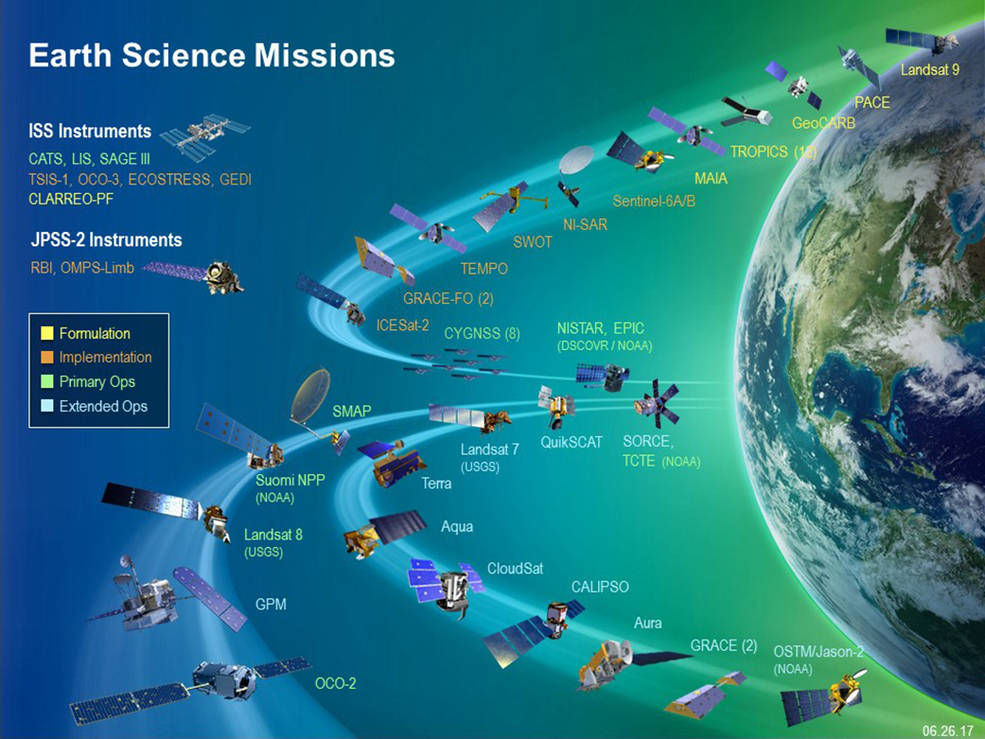Below 20 GHz
| 1215 MHz – 4400 MHz
1215-1300 MHz Space Research Services (SRS)/Earth Exploration Satellite (EES) – Active
1370-1427 MHz Space Research Services (SRS)/Earth Exploration Satellite (EES) – Passive
1435-1535 MHz Aeronautics Telemetry
1750-1850 MHz Space Research Services (SRS) – Earth-to-Space Region 2
2025-2110 MHz Space Research Services (SRS)/Earth Exploration Satellite (EES) – Earth-to-Space, Space-to-Space
2110-2120 MHz Space Research Services (SRS) – Deep Space
2200-2290 MHz Space Research Services (SRS) – Deep Space
2290-2300 MHz Space Research Services (SRS) – Deep Space
2360-2385 MHz Aeronautics Telemetry
2690-2700 MHz Earth Exploration Satellite (EES)/Space Research Services (SRS) – Passive
3100-3300 MHz Earth Exploration Satellite (EES)/Space Research Services (SRS) – Active
4200-4400 MHz Earth Exploration Satellite (EES)/Space Research Services (SRS) – Passive
| 4950 MHz – 9800 MHz
4950-5000 MHz Space Research Services (SRS) – Passive
5250-5570 MHz Earth Exploration Satellite (EES)/Space Research Services (SRS) – Active
5650-5725 MHz Space Research Services (SRS) – Deep Space
6425-7145 MHz Earth Exploration Satellite (EES)/Space Research Services (SRS) – Passive
7145-7235 MHz Space Research Services (SRS) – Earth-to-Space
8025-8400 MHz Earth Exploration Satellite (EES) – Space-to-Earth
8400-8500 MHz Space Research Services (SRS) – Space-to-Earth
8550-8650 MHz Earth Exploration Satellite (EES)/Space Research Services (SRS) – Active
9500-9800 MHz Earth Exploration Satellite (EES)/Space Research Services (SRS) – Active
| 10.6 GHz – 20 GHz
10.6-10.7 GHz Space Research Services (SRS)/Earth Exploration Satellite (EES) – Passive
12.75-13.25 GHz Space Research Services (SRS) – Space-to-Earth, Deep Space
13.25-13.4 GHz Space Research Services (SRS)/Earth Exploration Satellite (EES) – Active
13.4-14.3 GHz Space Research Services (SRS) – Tracking and Data Relay Satellite (TDRS) Forward at 13.775
14.5-15.2 GHz Space Research Services (SRS) – Tracking and Data Relay Satellite (TDRS) Return at 15.0034
15.2-15.4 GHz EES/Space Research Services (SRS) – Passive
16.6-17.1 GHz Space Research Services (SRS) – Earth-to-Space, Deep Space
17.2-17.3 GHz Space Research Services (SRS)/Earth Exploration Satellite (EES) – Active
18.6-18.8 GHz Space Research Services (SRS)/Earth Exploration Satellite (EES) – Passive
Between 20 GHz and 100 GHz
| 20 GHz – 40 GHz
21.2-21.4 GHz Passive
22.21-22.5 GHz Passive
22.55-23.55 GHz Tracking Data Relay Satellite (TDRS) Forward
23.6-24 GHz Passive
25.25-27.5 GHz Tracking Data Relay Satellite (TDRS) Return
25.5-27 GHz Earth Exploration Satellite (EES)
31.3-31.8 GHz Passive
31.8-32.3 GHz Deep Space
34.2-34.7 GHz Deep Space
35.5-36.0 GHz Active
36.0-37.0 GHz Passive
37.0-38.0 GHz Lunar Martian
| 40 GHz – 100 GHz
40.0-40.5 GHz Lunar Martian
42.5-43.5 GHz Radio Astronomy
50.2-50.4 GHz Passive
52.6-59.3 GHz Passive GHz
65.0-66.0 GHz Earth Exploration Satellite (EES)/Space Research Services (SRS)
74.0-84.0 GHz Very Long Baseline Interferometry (VLBI)
86.0-92.0 GHz Passive
Above 100 GHz
| 100 GHz – 350 GHz
100.0-102.0 GHz Space Research Services (SRS)/Earth Exploration Satellite (EES) – Passive
105-116 GHz Space Research Services (SRS)/Earth Exploration Satellite (EES) – Passive
116-122.25 GHz Space Research Services (SRS)/Earth Exploration Satellite (EES) – Passive
133.5-134.0 GHz Earth Exploration Satellite (EES) – Active
148.5-151.5 GHz Space Research Services (SRS)/Earth Exploration Satellite (EES) – Passive
155.5-158.5 GHz Space Research Services (SRS)/Earth Exploration Satellite (EES) – Passive
164.0-167.0 GHz Space Research Services (SRS)/Earth Exploration Satellite (EES) – Passive
174.8-191.8 GHz Space Research Services (SRS)/Earth Exploration Satellite (EES) – Passive
200.0-209.0 GHz Space Research Services (SRS)/Earth Exploration Satellite (EES) – Passive
217.0-226.0 GHz Radio Astronomy (Space Research Passive)
222.6-231.5 GHz Space Research Services (SRS)/Earth Exploration Satellite (EES) – Passive
235.0-237.9 GHz Space Research Services (SRS)/Earth Exploration Satellite (EES) – Passive
237.9-238.0 GHz Space Research Services (SRS)/Earth Exploration Satellite (EES) – Active, Passive
250.0-252.0 GHz Space Research Services (SRS)/Earth Exploration Satellite (EES) – Passive
275.0-277.0 GHz Space Research Services (SRS)/Earth Exploration Satellite (EES) – Passive
294.0-306.0 GHz Space Research Services (SRS)/Earth Exploration Satellite (EES) – Passive
316.0-334.0 GHz Space Research Services (SRS)/Earth Exploration Satellite (EES) – Passive
342.0-349.0 GHz Space Research Services (SRS)/Earth Exploration Satellite (EES) – Passive
| 350 GHz – 1000 GHz
363.0-365.0 GHz Space Research Services (SRS)/Earth Exploration Satellite (EES) – Passive
371.0-389.0 GHz Space Research Services (SRS)/Earth Exploration Satellite (EES) – Passive
416.0-434.0 GHz Space Research Services (SRS)/Earth Exploration Satellite (EES) – Passive
442.0-444.0 GHz Space Research Services (SRS)/Earth Exploration Satellite (EES) – Passive
496.0-506.0 GHz Space Research Services (SRS)/Earth Exploration Satellite (EES) – Passive
546.0-568.0 GHz Space Research Services (SRS)/Earth Exploration Satellite (EES) – Passive
624.0-629.0 GHz Space Research Services (SRS)/Earth Exploration Satellite (EES) – Passive
634.0-654.0 GHz Space Research Services (SRS)/Earth Exploration Satellite (EES) – Passive
659.0-661.0 GHz Space Research Services (SRS)/Earth Exploration Satellite (EES) – Passive
684.0-692.0 GHz Space Research Services (SRS)/Earth Exploration Satellite (EES) – Passive
730.0-732.0 GHz Space Research Services (SRS)/Earth Exploration Satellite (EES) – Passive
851.0-853.0 GHz Space Research Services (SRS)/Earth Exploration Satellite (EES) – Passive
951.0-956.0 GHz Space Research Services (SRS)/Earth Exploration Satellite (EES) – Passive
Research
NASA’s requirements for access to the radio frequency spectrum began with the formation of the agency in 1958 and have evolved and grown over the decades to include a wide array of programs and applications. Virtually every endeavor by the agency requires communications or data transfer via the radio spectrum.
Today and in the coming years, NASA will implement programs to achieve missions encompassing space exploration, scientific research, and technology development. These initiatives are taken in response to National Policy directives as well as Congressional legislation.
EARTH SCIENCE
Earth Science research at NASA has turned space-based observing technology and scientific expertise to the study of our home planet. Planet Earth is an integrated system of land, ocean, atmosphere, ice, and biological processes. From the vantage point of space, we are beginning to understand how these processes work and how they interact.
In order to support the intermediate and long term goals of understanding the Earth, NASA has developed numerous radio sensors designed to fly onboard spacecraft. These sensors may be passive or active in operation. They allow global “pictures” to be taken of the Earth on a daily basis in a wide range of frequencies. Passive sensors emit no energy; instead, they measure the natural emissions of the Earth’s various features and its atmosphere at specific frequencies in order to provide a description of the earth’s environment. Active sensors are spaceborne radars that provide information on the geological structure of the Earth and the state of and movement of Earth’s oceans. The data collected by these sensors is transmitted by radio links to facilities on earth, either directly or through relay satellites.
SPACE SCIENCE
NASA’s Space Science missions are intended to examine the mysteries of the universe from origins to destiny, to explore the solar system, to discover planets around other stars, to search for life beyond Earth and to chart the evolution of the universe and understand its galaxies, stars, planets and life.
Space science missions require highly reliable communications, often over long periods of time and great distances. The large distances involved in deep-space research result in a need for high power transmitters and very sensitive receivers at Earth stations that communicate with the spacecraft, factors which must be taken into account in spectrum planning efforts. Because many deep-space missions continue for periods of several years, and because there are usually several missions in progress at the same time, there is a corresponding need for communication with several spacecraft at any given time. Coverage of simultaneous missions requires nearly continuous usage of radio frequency bands allocated for space research communication.
AERONAUTICS
The focus of this program is to pioneer the identification, development, verification, transfer, application and commercialization of high-payoff aeronautics and space transportation technologies. NASA requires access to the radio spectrum in order to conduct test and development phases of new technology endeavors in aeronautics and space transportation. In many cases, new technological design test-rigs and/or prototypes undergo their various test and validation phases using conventional spectrum allocations for mobile or point-to-point operations.
For links between in-flight aerospace vehicles and ground systems, NASA requires access to aeronautical telemetry frequency allocations. Currently the radio frequency spectrum is used to provide real time data information from test vehicles to the ground, real time video of cockpit or project information, and real time command and control of the vehicle, including flight termination. Telemetry is used for the real time monitoring of flight research/test parameters that are necessary in order to minimize the risk to the pilot and aircraft during the performance of maneuvers intended to push the flight envelope of flight test vehicles.
SPACE EXPLORATION
NASA seeks to open the space frontier through exploration with the goal of enabling the development of space and expanding the human experience into the far reaches of the solar system. In exploring space, NASA has brought together a wide range of technologies, machines and people in the development of such programs as the Space Transportation System (STS) commonly known as the Space Shuttle, the International Space Station and the various Mars rovers. These programs require extremely complex radio systems, which are critical to their operation and currently include frequencies from about 100 MHz up to more than 30 GHz.





























